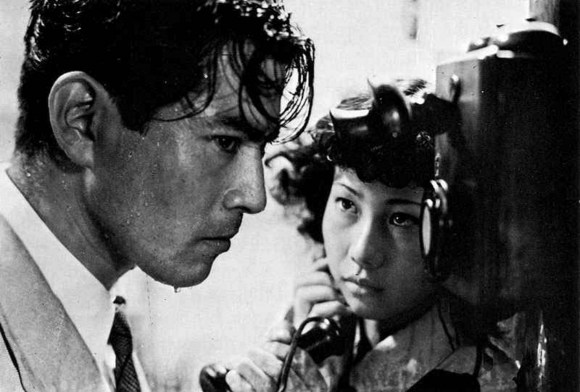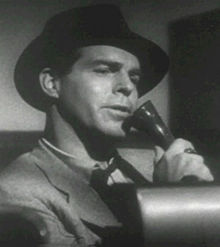This article continues on from my earlier post: The Debt to, and Divergences from, Hollywood Cinema in Jean-Luc Godard’s A Bout de Souffle and Juzo Itami’s Tampopo. I have decided to produce a full range of reviews and analysis’s of non-Hollywood film. As the title indicates I will start with the brilliant Stray Dog.
Stray Dog (1949)

Akira Kurosawa’s film contains both allusions to and major differences from Hollywood cinema. One major divergence is the disturbance of graphical clarity. A common aspect of the continuity editing system graphical clarity ensures that the mediating nature of film and the camera are allowed to remain hidden and unacknowledged. Kurosawa’s Stray Dog disrupts clear graphical construction in a scene by filming through a beaded doorway, therefore creating a disrupted and blocked view of the film’s two main protagonists. In the continuity editing system ‘the camera remains relatively unobtrusive, seldom drawing attention to its mediating presence.’ (1) to facilitate this unobtrusive camera style directors’ choose clear and unobstructed views of action which won’t draw attention to the fact that we are watching a film. Even if a director chooses an obstructed view we tend to be given a subjective position, one that does not bring attention to the fact that the screens’ images are mediated through a cameraman. If we are given an obstructed view we are given a reason behind the blocked view. The collection of conventions concerning graphical clarity are contradicted in Kurosawa’s Stray Dog. Because we are viewing the action through a beaded doorway we notice our disadvantaged position; we notice how hindered and disrupted our view is and we are offered no reason why we should view from this particular angle. We become conscious of the mediating force that is cinematography. Kurosawa uses this to remind us of the conventions of cinema. Kurosawa uses the technique to disturb our position of knowledge by inferring that all we can perceive is that which the camera, and director, wishes to. Our experience is defined by the mediating force in the same way the characters are defined by what they see. Kurosawa seems to be highlighting this because experience and subjective perception is important in the narrative of Det. Murakawi, both as he learns from the sage Det. Sato and in the revelation of his own similar experiences to the antagonist Shinjiro Yusa; the man with Murakawi’s gun committing the crimes that rack Murakawi with guilt.

Akira Kurosawa’s Stray Dog alludes to the Hollywood cinematic forms of Film Noir and the Gangster Film. In one scene a villain, Honda, is called to a front gate of a Baseball stadium by a tannoy system. As he walks down a flight of stairs the screen composition changes and the lighting produces a dark Noir-like affect. Honda, dressed similar to many an archetypal gangster, enters the scene in a normal naturalistic light, however the further he descends down the stairs the further Akira Kurosawa intensifies the sharp contrasting tones producing a chiaroscuro-style scene. Honda wears a white linen pin-stripe suit, as he becomes aware he may be walking into a trap the Camera reverses position and shows only a black silhouette of Honda enveloped by the darkness; his fate is sealed, his relationship with the gun-girl leads to the police locating him, just like many gangster films and film Noirs Honda’s cool command and apparent invincibility is breached through a contaminated relationship with a woman. Honda is a small homage to the doomed antagonist/protagonist of the Noir and gangster films of Hollywood.
The skilful use of lighting in this scene is also an allusion to German Expressionism and the stark contrast between subject and surroundings symbolised by Honda’s change from white linen suit to dark silhouette is a typical chiaroscuro technique found in films such as The Cabinet of Dr. Caligari(1920). Paul Schrader notes that a common trait of Film Noir is the use of ‘Shadow effects [which are] unlike the famous Warner Brother’s lighting of the thirties in which the central character was accentuated by a heavy shadow; in Film Noir the central character is likely to be standing in the shadow.’ (2) Kurosawa is using this exact technique in the scene with Honda, he is defining Honda’s character and fate as one in the shadows.

Another allusion to Film Noir stylistics is the use of water. Film Noir is noted for an ‘attachment to water. The empty Noir streets are almost always glistening with fresh evening rain… and the rainfall always seems to increase in proportion to the drama.’ (3) As the film moves to a conclusion rain starts to pelt down relentlessly, The rain increases as the potential confrontation between Murakami and the desperate thief Shinjuro Yusa becomes more and more likely and it is in fact the rain, and the mud that sprays onto Yusa’s trousers as he flees after shooting Sato, that allows the confrontation and eventual capture of Yusa.

Akira Kurosawa’s Stray Dog both alludes to Hollywood cinematic genres and contains major divergences from the Continuity System. In this aspect Akira creates a film that contains both national elements of note and internationally recognizable symbols and allusions and therefore Akira has created a brilliant film.

1. Richard Maltby, Hollywood Cinema, Oxford: Blackwell Publishing, (2003), p. 312.
2. Paul Schrader,’Notes On Film Noir’ in Barry Keith Grant, Film Genre Reader II, Austin: University of Texas Press, (1999) pp. 213-226 p. 219.
3. Paul Schrader, ‘Notes On Film Noir’, p. 220.








